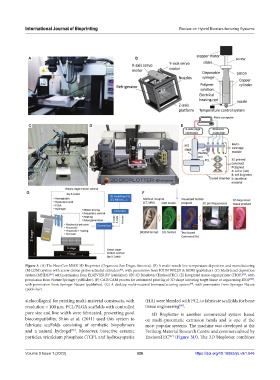Page 334 - IJB-9-1
P. 334
International Journal of Bioprinting Review on Hybrid Biomanufacturing Systems
A B
C D E
G F
Figure 3. (A) The NovoGen MMX 3D Bioprinter (Organovo, San Diego, America). (B) A multi‑nozzle low‑temperature deposition and manufacturing
(M-LDM) system with screw-driven piston actuated extruders , with permission from JOHN WILEY & SONS (publisher). (C) Multi‑head deposition
[62]
system (MHDS) , with permission from ELSEVIER BV (publisher). (D) 3D Bioplotter (EnvisonTEC). (E) Integrated tissue-organ printer (ITOP) , with
[59]
[64]
permission from Nature Springer (publisher). (F) CAD/CAM process for automated printing of 3D shape imitating target tissue or organ using ITOP ,
[59]
with permission from Springer Nature (publisher). (G) A desktop multi‑material biomanufacturing system , with permission from Springer Nature
[74]
(publisher).
atelocollagen) for printing multi-material constructs, with (HA) were blended with PCL to fabricate scaffolds for bone
resolution < 100 µm. PCL/PLGA scaffolds with controlled tissue engineering .
[66]
pore size and line width were fabricated, presenting good 3D Bioplotter is another commercial system based
biocompatibility. Shim et al. (2011) used this system to on multi-pneumatic extrusion heads and is one of the
fabricate scaffolds consisting of synthetic biopolymers most popular systems. The machine was developed at the
and a natural hydrogel . Moreover, bioactive ceramic Freiburg Material Research Centre and commercialized by
[65]
particles, tricalcium phosphate (TCP), and hydroxyapatite EnvisonTEC (Figure 3D). The 3D bioplotter combines
[67]
Volume 9 Issue 1 (2023) 326 https://doi.org/10.18063/ijb.v9i1.646

